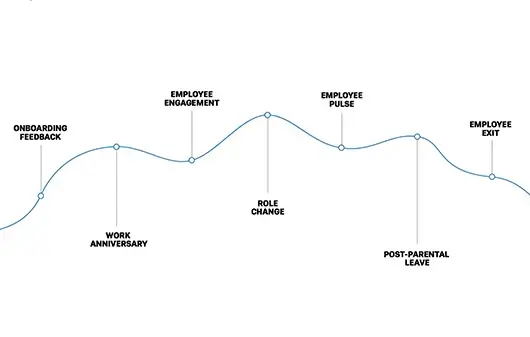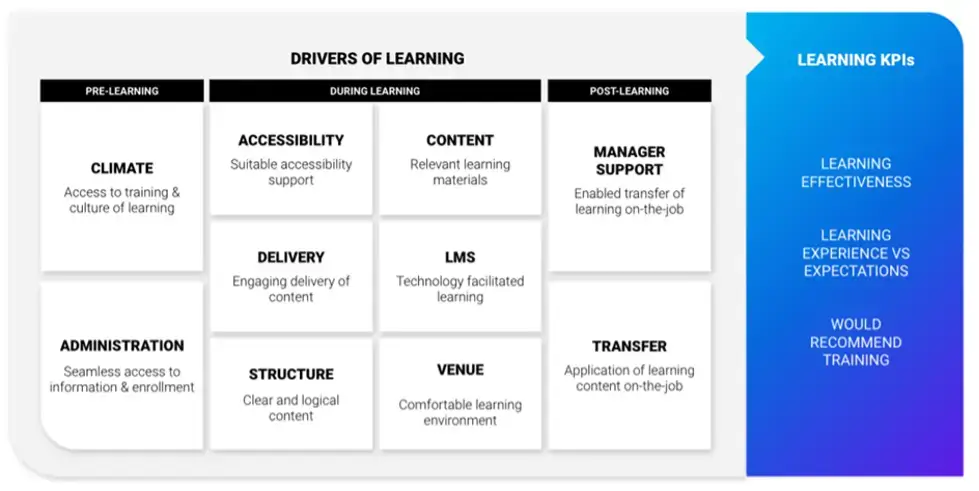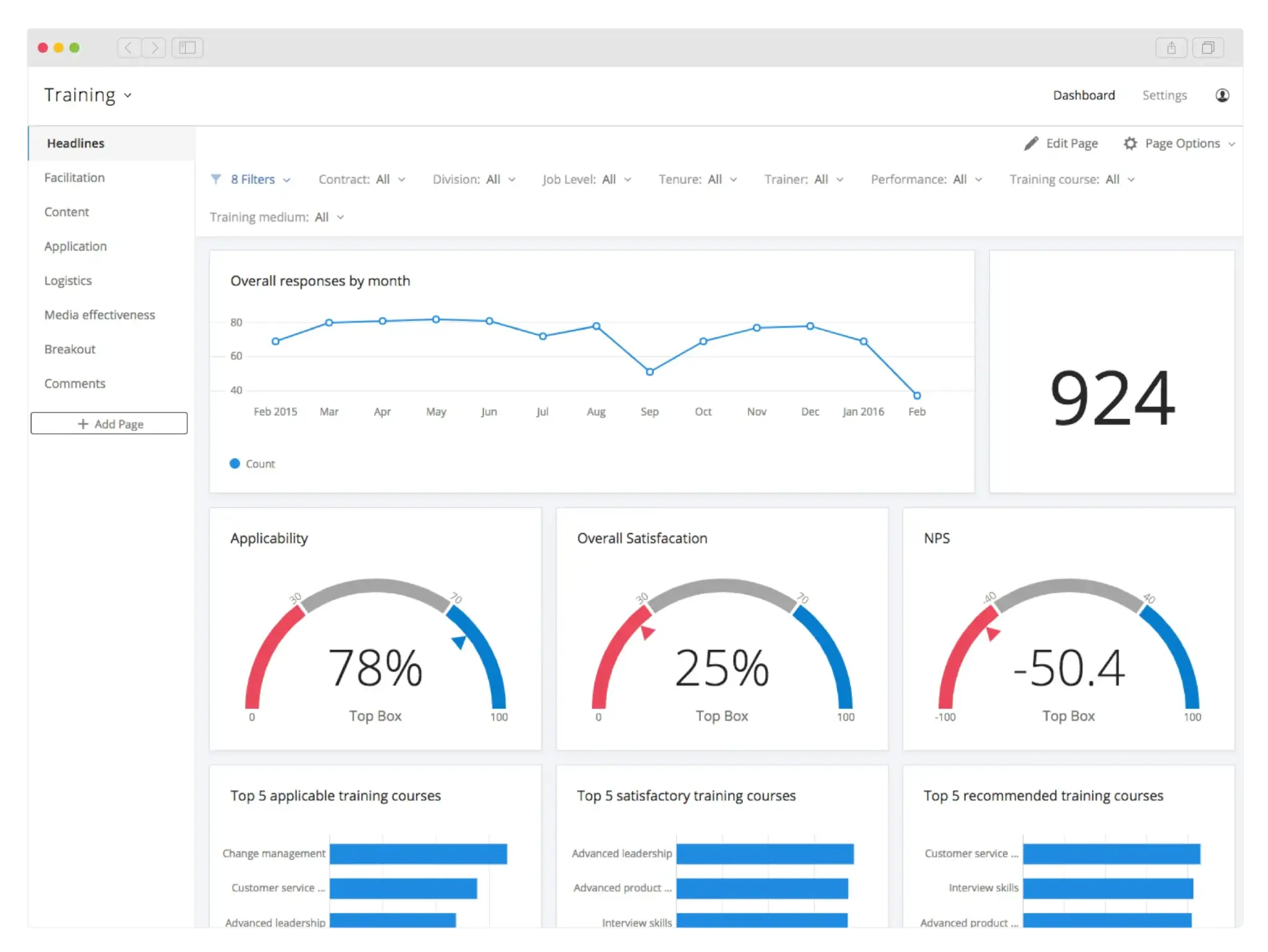What is a training survey?
It’s essential that you know how effective your training is, and you can find out using a training survey. Learner feedback can help you measure the effectiveness of each training session, improve them, and plan future training.
There are two types of training feedback survey:
1. Pre-training survey
To inform how you run the training sessions, how you deliver them, and what useful and relevant content they should have. It will also tell you about training survey participants’ existing knowledge, expectations, needs, and wants.
2. Post training survey
These help you take a long, hard look at the outcomes of your training, making sure it fulfilled your goals and offered value for money, and informing future training programs.
Get started with our free survey maker tool
Why should you run a training survey?
When you invest in training for your employees, they become more valuable to your organization. That’s because developing your employees:
- gives them a greater sense of self-worth
- leads to increased productivity and career growth
- reduces the need for constant supervision
- reduces employee turnover
According to estimates, US organizations spend between $80-$90B ($350-400B globally) per year on learning and development (L&D).
Despite this, according to the Harvard Business Review:
75% of managers are dissatisfied with their organization’s L&D
- 70% of employees report they don’t have the mastery of skills to do their jobs
- 12% of employees apply skills learned in their programs to their jobs
- 25% of respondents to a McKinsey study believe that training improves performance.
This data suggests there’s a substantial gap between learning spend and actual outcomes for organizations.
To help close this substantial gap, you will need to understand how effective your training is. Ideally, your training will be tailored to impact your organization’s most important key performance indicators (KPIs), such as:
- sales growth
- customer engagement
- return on investment (ROI)
- employee engagement
- employee turnover
When you run training surveys along your employee lifecycle you’ll be able not only to measure the learning outcomes but also track how the training has impacted an employee’s performance over time.

And, when the results of your training surveys sit alongside all your other employee feedback data (performance reviews, employee engagement, productivity) on the same platform, you’ll easily be able to join the dots to see at which stage your training program has the strongest impact on the employee lifecycle.
You’ll understand how the quality of your training affects the employee experience from onboarding ramp time, career development and succession planning, employee engagement and attrition, pinpointing areas that demonstrate a need for improvement.
What to ask in your training survey
We think there are three fundamental questions leaders need to know answers to, in order to assess how effective their training programs are:
1. How accessible are learning opportunities in the organization?
2. What is the quality of training currently being offered?
3. Are the skills learned in training being transferred to the workplace and sustained over time?
These questions are designed to capture feedback from both learners and their managers to assess both the quality of training programs, training effectiveness, and the extent to which the training has positively impacted the workplace.
Broadly speaking, there are two question types that capture “need to know” feedback about learning programs:
1. Quantitative (objective and factual, straightforward to count)
- Single choice or multiple choice
- Likert scale
- Rating or ranking
2. Qualitative (subjective and based on opinion, requires text or conversational analysis to measure)
You have many types of question and responses to choose from to measure quantitative and qualitative data, including:
- Closed-ended questions
- Text entry (open-ended questions)
Critical topics to measure and improve with your training surveys
We’ve identified 10 key drivers that are critical to creating an effective learning experience (pre-training, during training and post-training) for virtual, face-to-face, and blended training:

Pre-training survey questions
There are two training experience drivers for pre-training:
1. Climate
Does the organization have a culture of learning and training? Can employees grow and develop? With an organizational culture that doesn’t support learning and sharing knowledge (maybe because it is shortsighted or under-resourced), employees may find learning opportunities few and far between, or are unable to apply what they’ve learned to their work.
Questions about climate should cover access to training and the company’s learning culture.
2. Administration
Adult learners tend to learn because they want to, rather than being told to, and see the benefits of training. They are also practical, and need to feel that access to training is easy and readily available.
You need to understand the challenges associated with pre-training logistics and/or administration. By understanding these, you’ll be able identify what learners find difficult about accessing training, and causes for low program adoption.
Questions about administration should ask about whether access to training information and enrollment is seamless.
Pre-training surveys don’t need to be very long, but they are useful for identifying demand, knowledge gaps, and expectations of the training. You’ll be able to tailor your training to meet identified training needs.
Here are some pre-training survey question examples:
(if response to any of the previous items is neutral or unfavorable)
(if response to any of the previous items is neutral or unfavorable)
⁹ Unless otherwise specified, response scales are
Strongly disagree | Disagree | Neither agree nor disagree | Agree | Strongly agree
During training survey questions
During training evaluation is all about measuring your learners’ reactions to the training itself. It’s usually measured once the training modules are completed.
1. Accessibility
This is all about making training sessions and content available to a diverse range of people with different needs, and barriers to access, including:
- People with disabilities
- Neurodivergent people
- Older employees
- People with access to only one device
By considering all these needs and incorporating access for all learners into your training programs, you increase engagement with the learning content.
2. Content
When we think of engaging content, we often think of it as fun, interactive or relatable. Such content may well be engaging, but we need to consider it from the point of view of learning. Engaging, relevant training content should take into account what learners already know, and build on that in the appropriate order.
It can be fun, interactive or relatable for some early wins, but then it should supply enough practice and extension to fill gaps in learning and challenge. The best content isn’t designed to be consumed passively: it should stimulate behaviors that help make the learning stick.
3. Delivery
The impact and reach of good quality professional training stands or falls on the delivery – both by the presenter, and method of delivering the material. When you actively, rather than passively, engage learners (a hands-on workshop as opposed to a lecture involving a PowerPoint presentation), they’re more likely to:
- Retain the learning content
- Apply it to their own role and projects
- Share what they’ve learned with co-workers
Some learners already have knowledge of or expertise in, the training topics, and good training delivery encourages robust conversations and interesting questions that can engage the whole room.
4. Learning Management System (LMS)
An LMS is an online platform for distributing online training courses, a depot to store them, and also an effective way of delivering, tracking, and assessing training.
An LMS keeps all your training content centralized so all learners have a single source they can go to for course content, instructions and questions. Another advantage of using an LMS is to easily gather data on training progress, learner satisfaction, and costs. When you have an effective and well-implemented LMS, not only will you be able to offer engaging and interactive courses but the system should be easy to use, intuitive, reliable, and scalable.
5. Structure
This is how much the training program has been designed to enable participants to enhance knowledge retention so that they can later apply what they’ve learned to their job. A good course structure will involve:
- determining and planning the appropriate activities to be carried out
- the selection of appropriate training methods
- helping learners achieve their objectives
- appropriate duration of training
- well-paced training
- training material that are structured logically and easy to follow.
- the achievements required by the participants at the end of the training program
6. Venue
For non-remote training courses, the place where you train people plays a big role in how well they retain information. Your training environment affects engagement as much as office desks workstations do. For employees to focus on training and learn effectively, you must create a comfortable space:
- Technology should work seamlessly and reliably
- The room’s temperature must be comfortable and controllable
- Seats must be comfortable
- Catering quality should be high
- There must be space to move around and see the trainer.
Survey immediately after every training session (no more than 24 hours afterwards), to collect feedback while it’s still fresh in the participants’ minds.
Here are some ‘during’ sample training survey questions examples:
(if response to any of the previous items is neutral or unfavorable)
⁹ Unless otherwise specified, response scales are
Strongly disagree | Disagree | Neither agree nor disagree | Agree | Strongly agree
Post training survey questions
There’s no point to training if employees don’t take what they’ve learned back to their jobs and apply it. There’s little to be gained from a training course that’s well received by learners if nothing changes back in the office or on the shop floor.
Evaluating post-training implementation and application of the learning is an essential part of training surveys. It covers various factors including:
- motivation to learn
- work environment and support
- opportunity to practice newly acquired knowledge or skills
You should assess the extent to which learners have been able to apply skills or change behaviors several months after the training has concluded, depending on the situation. It’s important to remember, though, that behavioral change as a result of training only happens with:
- manager support
- learner motivation
- the right conditions to practice new skills
For this reason, post-learning surveys ask for feedback from both learners and their managers.
There are two training experience drivers for post-training:
1. Manager support
One of the most significant barriers to transferring training learnings is having too few opportunities to apply the newly acquired skills in the workplace. Often, even if employees are given the time to learn, previous work duties take priority, and they may feel they don’t have time to apply what they’ve just learned.
Therefore, you need to find out whether managers think a learner has used their newly acquired skills when they came back to work. Also, transfer of learnings can only happen if the right support is available to the learner. So, the drivers are designed to understand what role managers play in supporting returning participants in their job development, and what barriers may be getting in the way of applying new learning to the workplace.
2. Transfer
Similar to Manager Support, drivers in this category focus on training transfer:
- application of knowledge and skills acquired in training to the job
- maintenance of learning
- perceived support from managers
- obstacles to applying learning on the job
- opportunities for applying learning on the job
In post-training surveys, you don’t just ask about drivers, you can also ask about the Key Performance Indicators for training to assess your whole program:
LEARNING EXPERIENCE KPIs
Learning Effectiveness
This KPI assesses the overall effectiveness of the training content and delivery.
It’s a combination of:
1. Knowledge Acquisition: To what extent do learners feel they have learned something new as a result of the training?
2. Relevance: Most adult learners are more likely to engage with a learning program when it has clear relevance for them. This KPI measures the relevance of the learning.
3. Application: People learn quickly, and remember what they learn when they can apply that new knowledge to their role. This KPI measures how much learners feel they can apply their learning on the job.
Recommend
This KPI simply and transparently asks learners whether they would recommend this training to others.
People who recommend the training do so because they want to share their positive experience with others, not for personal gain or rewards. A positive recommendation score is a powerful measure of the overall learning experience’s quality.
Learning Experience vs Expectations
This KPI measures explicitly whether the learning program met expectations.
When organizations offer high-quality learning programs that meet learners’ needs, this KPI helps ensure that all learners have access to learning content that meets and even exceeds their expectations.
Here are some post-training question examples – note the KPI questions and open-ended feedback before the drivers:
To what extent did the training meet your expectations?
- Far below my expectations
- Below my expectations
- Met my expectations
- Exceeded my expectations
- Greatly exceeded my expectations
Please give your reason for your rating (open-ended item)
⁹ Unless otherwise specified, response scales are
Strongly disagree | Disagree | Neither agree nor disagree | Agree | Strongly agree
Best practice for training survey questions
There’s a lot to think about when you design a survey that your respondents will love. If you follow these five simple rules for writing training evaluation questions, you’ll be able to produce a great post training evaluation survey that gives you insightful, measurable feedback on your training process every time:
1. Keep it short and to the point – it’s not the annual survey.
2. Be concise – make survey questions as simple, and with as few words as possible. This way you avoid them being vague, ambiguous or open to interpretation, which will improve your rate of survey responses.
3. Write as you speak – make survey questions conversational and avoid jargon or over-technical vocabulary.
4. Vary the survey question styles – you have a whole lot of question styles at your disposal, so use them to avoid respondent boredom. It’s important to include open text entry so people can provide unstructured feedback.
5. Test your survey – run it past a friend or colleague to make sure they can easily use and understand it. Then tweak it accordingly.

But you don’t have to do all this yourself. Our training feedback solutions are included for all our customers.
Get started with our free survey maker tool